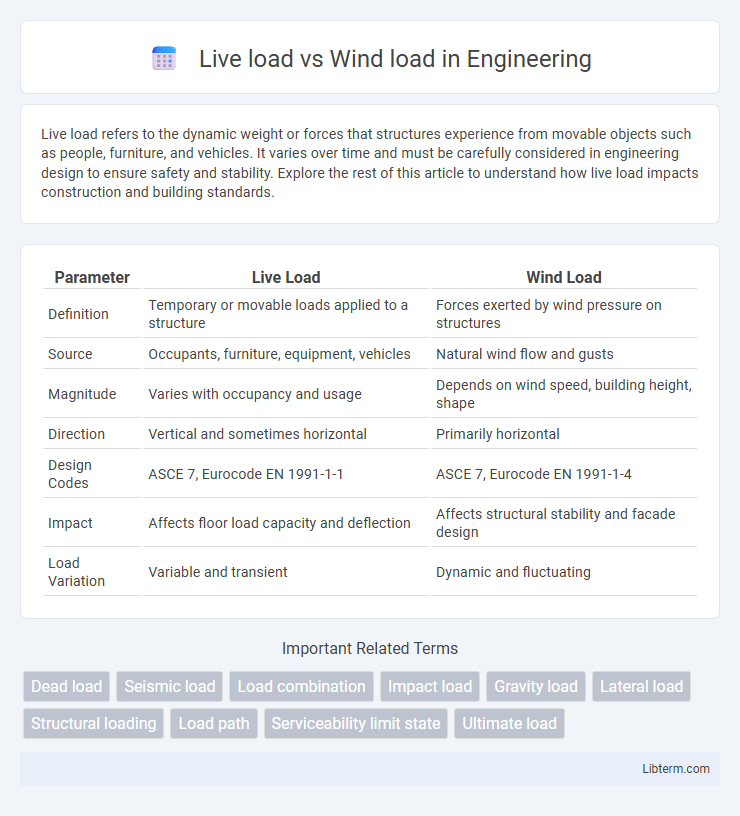Live load refers to the dynamic weight or forces that structures experience from movable objects such as people, furniture, and vehicles. It varies over time and must be carefully considered in engineering design to ensure safety and stability. Explore the rest of this article to understand how live load impacts construction and building standards.
Table of Comparison
| Parameter | Live Load | Wind Load |
|---|---|---|
| Definition | Temporary or movable loads applied to a structure | Forces exerted by wind pressure on structures |
| Source | Occupants, furniture, equipment, vehicles | Natural wind flow and gusts |
| Magnitude | Varies with occupancy and usage | Depends on wind speed, building height, shape |
| Direction | Vertical and sometimes horizontal | Primarily horizontal |
| Design Codes | ASCE 7, Eurocode EN 1991-1-1 | ASCE 7, Eurocode EN 1991-1-4 |
| Impact | Affects floor load capacity and deflection | Affects structural stability and facade design |
| Load Variation | Variable and transient | Dynamic and fluctuating |
Introduction to Live Load and Wind Load
Live load refers to the variable forces imposed on structures by occupants, furniture, and movable equipment, influencing structural design for safety and serviceability. Wind load encompasses the forces exerted by wind pressure on buildings, critical for ensuring stability and resistance against lateral forces. Understanding both loads is essential for accurate structural analysis and resilient building performance.
Defining Live Load: Meaning and Examples
Live load refers to the temporary, dynamic forces exerted on a structure, such as the weight of occupants, furniture, vehicles, and movable equipment. Unlike wind load, which is a static external force caused by atmospheric pressure and velocity, live load varies based on the use and occupancy of the building. Examples of live load include people walking inside a building, storage materials on floors, and vehicles on a bridge.
Understanding Wind Load: Basics and Types
Wind load refers to the force exerted by wind pressure on structures, influenced by factors such as wind speed, direction, terrain roughness, and building shape. Understanding wind load involves analyzing both static pressure and dynamic effects like gusts and vortex shedding, which impact the structural stability and design. Types of wind load include lateral wind pressure, uplift forces on roofs, and torsional loads, all critical for ensuring building safety and resilience against wind-induced stresses.
Key Differences Between Live Load and Wind Load
Live load refers to the temporary or movable forces exerted on a structure, such as people, furniture, or vehicles, which vary in magnitude and location. Wind load represents the lateral or horizontal forces applied by wind pressure on the surfaces of a building, often causing stress perpendicular to the structure. The key differences lie in their origin--live loads are dynamic and variable internal forces, while wind loads are external, directional pressures influenced by environmental conditions.
Importance of Accurate Load Calculations in Structures
Accurate load calculations for live load and wind load are critical in structural engineering to ensure safety, stability, and compliance with building codes. Live loads, representing variable weights from occupants and movable objects, differ significantly from wind loads, which apply dynamic lateral forces based on local wind speed, direction, and terrain category. Precise assessment of these loads prevents structural failure, optimizes material use, and extends the lifespan of buildings under diverse environmental conditions.
Factors Influencing Live and Wind Loads
Live load is influenced by occupancy type, usage patterns, and movable objects within a structure, affecting the distribution and magnitude of loads. Wind load factors depend on building height, shape, surrounding terrain, and local wind speed data, which determine pressure intensity and directional forces on the structure. Structural design must account for variability in live load due to human activity and in wind load due to meteorological conditions and geographic location.
Code Requirements for Live and Wind Loads
Building codes such as ASCE 7 specify distinct requirements for live and wind loads, outlining minimum design loads for structural safety and serviceability. Live loads account for temporary weights like occupants and movable equipment, typically defined in pounds per square foot (psf) and varying by occupancy type, while wind loads are calculated based on factors such as wind speed, exposure category, and building geometry to resist lateral forces. Compliance with these code-mandated load combinations ensures structures can safely withstand both vertical and lateral forces as per local jurisdictional standards.
Impact of Live Load vs Wind Load on Structural Design
Live load and wind load critically influence structural design by dictating different stress responses and safety factors. Live loads, including occupants and movable objects, primarily affect floors and beams, requiring designs that ensure sufficient load-bearing capacity and deflection limits. Wind loads impose lateral forces and torsion on structures, necessitating robust bracing, shear walls, and aerodynamic considerations to prevent sway and structural failure.
Common Misconceptions About Structural Loads
Live loads and wind loads are often misunderstood in structural engineering, with many assuming live loads are constant and wind loads are negligible. Live loads actually represent dynamic, variable forces from occupancy or movable objects, while wind loads are transient, exerting fluctuating pressure based on speed, direction, and building exposure. Engineers must accurately differentiate these loads for safety compliance, as misjudging wind load effects can lead to under-designed structures and misapplying live load assumptions risks incorrect safety margins.
Conclusion: Choosing the Right Design Approach
Selecting the appropriate design approach depends on the specific structural demands, with live loads representing variable forces like occupancy and movable objects, while wind loads involve dynamic pressure exerted by airflow on surfaces. Engineers prioritize live load considerations in buildings with significant occupant movement or heavy equipment, whereas wind load design is crucial in high-rise structures or areas prone to strong winds and storms. Balancing both load types ensures safety, serviceability, and cost-efficiency in structural design.
Live load Infographic

 libterm.com
libterm.com